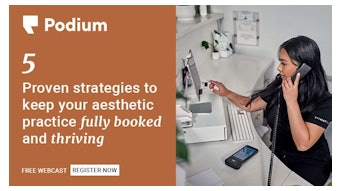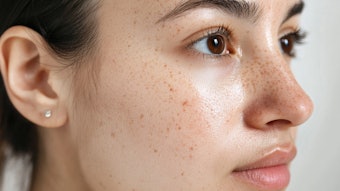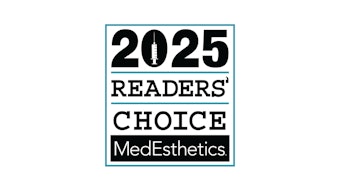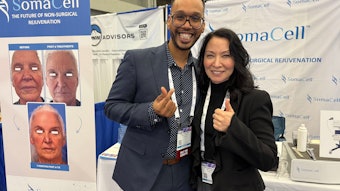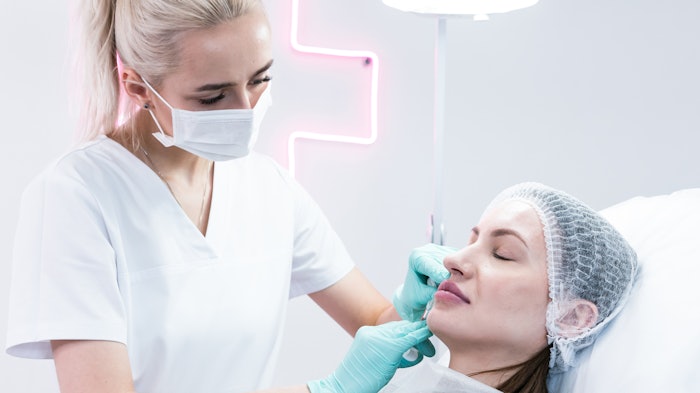
A group of five medical aesthetic professionals in the U.K. convened to develop step-by-step consensus guidelines on improving aseptic injection standards in aesthetic clinical practice. The guidelines were accepted for publication in Dermatologic Therapy (October 17, 2020). Authors Rachna Murthy, MD, David Eccleston, MD, Darren Mckeown, MD, Apul Parikh, MD, and Sophie Shotter, MD, reviewed current evidence as well as their own extensive clinical experience and came up with the following recommendations:
Patient Selection
Selecting appropriate patients and not treating inappropriate patients is crucial for avoiding complications with soft tissue fillers. This requires a thorough patient history of skin conditions, as well as allergies, systemic disease, current medication and previous procedures.
Disruption of the skin due to inflammatory or infective conditions, such as rosacea, dermatitis or Herpes simplex may also permit infection. Therefore pre-treatment of underlying conditions is important to enable adequate healing time to restore the skin’s barrier function. Patients with a history of cold sores or fever blisters may be pre-treated with antivirals such as acyclovir, famciclovir or valacyclovir to reduce the severity and duration of cutaneous herpes infections and prevent virus reactivation, especially when injecting in the perioral area and lips.
Practitioners should defer injectable treatments in patients with active acne lesions as well as those with influenza, sinusitis, periodontal disease, ear, nose, or throat infections, dental abscesses or recent dental surgery until the condition is resolved.
Caution should be used when considering dermal fillers in patients with compromised immune systems, such as with HIV, cancer treatment, immunotherapy or poorly controlled diabetes. In the event of infection in immunocompromised patients, the possibility of Candida species infection should be considered for those not responding to treatment with antiviral agents and antibiotics alone.
Pre-Treatment
Prior to the procedure, patients should be advised to come to the practice with clean, cosmetic-free skin. Hair should be kept away from treatment areas to reduce contamination risks, with hairbands used for both patient and injecting practitioner, if necessary. Clean, degrease and disinfect the treatment area.
Injectors should adhere to standard hospital guidance on handwashing and bare-below-elbow (BBE) procedures, including absence of wrist and hand jewelry, short and clean fingernails that are free of adornment or polish, and covering of minor cuts and abrasions with water proof dressings. All staff should wear clean-on uniforms or scrubs, which are not changed between patients unless visibly soiled. Patients should use a hypochlorous-based mouthwash for at least 30 seconds before treating the perioral area, in particular prior to lip treatments.
Reduce activity in the immediate area where the procedure is to be performed. Keep exposure of the susceptible treatment site to a minimum. Check all sterile treatment packs for evidence of damage or moisture penetration. Ensure all fluids and materials to be used are in date.
During the Procedure
Use sterile gloves. Ensure the treatment area is clean and disinfected and that contaminated/non-sterile items are not placed in a clean treatment field. Avoid multiple needle passes to reduce the risk of filler contamination and complications, such as chronic granulomatous inflammation. Frequently change needles and cannulas when utilizing multiple entry points (every 10 to 15 injections). Use particular care when treating areas with prior soft tissue filler that may be degrading, layering different products and introducing skin flora into old residual filler.
Injectors should adhere to planned treatment procedures, with additional appointments scheduled for patients requesting unplanned treatments. In the event of contamination, stop the procedure, change gloves and cannula/syringe, then address the contamination.
Post-Treatment
Advise patients not to use cosmetics for 24 hours post injection. In the event that cosmetics must be worn within 24 hours of the procedure, counsel patients to open a new and sealed pack or use pump-based foundations rather than previously opened pressed powders or non-pump-based preparations.
Facility Disinfection Guidelines
The authors offered the following consensus recommendations for facility disinfection: Within the treatment room, surfaces and objects should be disinfected regularly and between each patient. Particular attention should be paid to environmental cleaning of high-touch surfaces and items. To aid in patient management and cleaning schedules, keep the quantity of devices used for aesthetic procedures within the treatment room to a minimum.
Read the full paper here.

